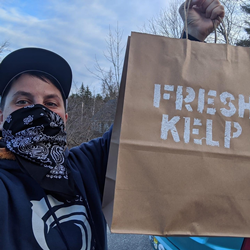
Owen Heil of Spartan Sea Farms/Pound of Tea Oysters delivers fresh kelp to southern Maine residents during the spring 2020 harvest season. Credit: Owen Heil
“By nature, Maine’s farm fishing families are open to navigating choppy waters when they need to. It’s our collective responsibility to support their efforts to bring their product to market,” said Sebastian Belle, executive director, Maine Aquaculture Association.
HALLOWELL, Maine (PRWEB)
March 01, 2022
The Maine Aquaculture Association (MAA) today released the first of its kind Maine Aquaculture Distribution Mapping Manual, a guide which helps sea farmers compare and contrast the existing and potential distribution channels for their products to best decide how to get them to market.
U.S. consumer demand for seafood is high. Retail seafood sales in the U.S. were up 35% to $7 billion in 2020 compared to 2019, according to market research company Information Resources, Inc.
With roughly 80% of all seafood being consumed in restaurants nationally, Maine aquaculture producers suffered severe loss of market during the early days of the pandemic when restaurants closed their doors. Alternative distribution methods including direct-to-consumer sales gained in popularity and continue to serve as an important channel.
“As Maine’s working waterfront continues to face new supply chain challenges, the industry and consumer demand keeps growing,” said Sebastian Belle, executive director, Maine Aquaculture Association. “By nature, Maine’s farm fishing families are open to navigating choppy waters when they need to. It’s our collective responsibility to support their efforts to bring their product to market.”
More than 20 stakeholders were interviewed to inform the manual, including seafood producers, wholesalers, distributors, restaurateurs, trucking companies, and other aquaculture industry members, both in Maine and across the U.S. The manual, which was funded in partnership with FocusMaine, puts forth three main recommendations to farmers, including: 1) diversify sales channels, 2) maintain strong relationships, and 3) keep product quality consistent.
“When the pandemic hit, our distribution chain changed, probably forever,” said Owen Heil, Pound of Tea Oysters and Spartan Sea Farms, Freeport. “We need to be informed about how to navigate shifts in the market to stay in business.” Owen and his partner Ken Sparta relied on local deliveries to sell their freshly harvested kelp and oysters when the pandemic hit in the spring of 2020.
“This manual is such a valuable tool,” said Toni Small, Ice House Oysters, Port Clyde. “From online sales to pop-ups and farmer’s markets, there are many routes to distribution. MAA walks us through the benefits and risks so we can make choices about where to put our efforts.”
Maine’s aquaculture industry currently represents nearly 200 farms and more than 700 farmers who produce premium seafood–fin fish, shellfish, and sea vegetables–in Maine’s cold, clean waters. The sector has been steadily growing in recent years, and its total economic impact has nearly tripled – from $50 million in 2007 to $137 million in 2014 – according to the latest Maine Aquaculture Economic Impact Report.
Sustainable aquaculture has tremendous potential to bolster Maine’s coastal economy, providing good jobs, local food security, and diversification opportunities for working waterfront families. Recently, on behalf of the Maine Aquaculture Hub, Maine Sea Grant and MAA released The Maine Aquaculture Roadmap, 2022-2032, a ten-year plan that proposes four major goals and identifies over $15 million in estimated resources needed to strengthen Maine’s aquaculture sector and working waterfronts over the next decade.
The Maine Aquaculture Distributing Mapping Manual will also serve to inform a collaborative project underway between MAA, the University of Maine School of Economics, Gulf of Maine Research Institute, Island Institute, and University of Maine Cooperative Extension that explores in greater detail the costs, volumes, availability, and reach of the identified distribution channels, along with consumer preferences for Maine seafood across the U.S. The ongoing project is funded via NOAA and Maine Sea Grant award number NA21OAR4170086.
The full list of recommendations is detailed in the report, which can be accessed here.
About the Maine Aquaculture Association
The Maine Aquaculture Association (MAA) est. 1978, is a nonprofit trade association that advocates for Maine’s fin fish, shellfish, and sea vegetable farmers. MAA’s mission is to support the state’s aquatic growers in developing economically and environmentally sustainable business practices, to promote the benefits of aquaculture in the local food system, and to preserve Maine’s heritage of a vibrant working waterfront.
Twitter | Facebook | Instagram | LinkedIn
Share article on social media or email:
For all the latest Life Style News Click Here
For the latest news and updates, follow us on Google News.
